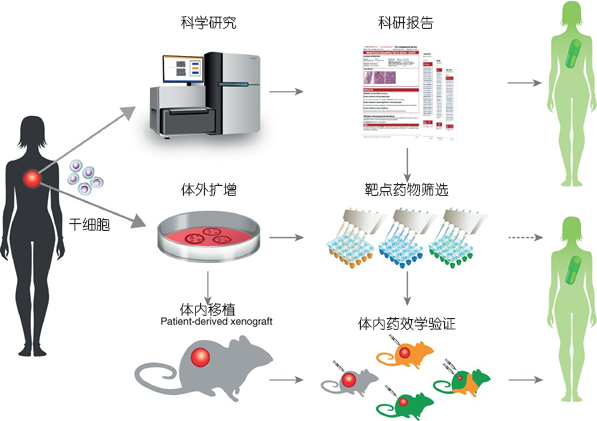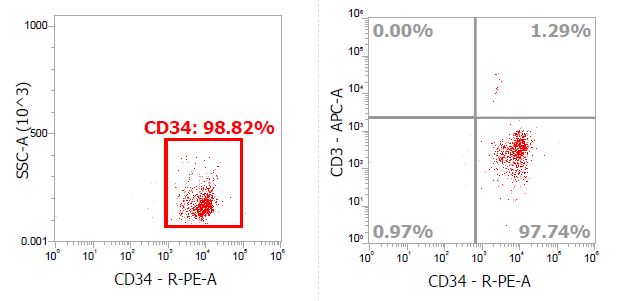Human Cord Blood CD34+ Cells 人脐血CD34细胞/造血干细胞(冻存)
货号:903410,903405,903403
规格:1 x 10^6细胞,5 x 10^5细胞,3 x 10^5细胞
价格:6000,4000,2600
产品类型:原代细胞
品牌:PBM
- 加入购物车 {"thumb":"\/data\/upload\/6155543d53527.PNG","photo":{"1":{"url":"\/data\/upload\/5fe15f5e5fac8.jpg","alt":"CD34"}}}
产品介绍
CD34 is a glycosylated transmembrane protein and represents a well-known marker for primitive blood- and bone marrow-derived progenitor cells, especially for hematopoietic and endothelial stem cells. CD34+ stem cells are multipotent and can differentiate to all hematopoietic cell types in blood. CD34+ cells can also give rise to all lymphohematopoietic lineages even though they comprise only a small percentage of the cell population.Our CD34+ cells are isolated using positive immunomagnetic cell separation procedures from single or mixed healthy donors. All cord blood is collected in Citric Phosphate with Dextrose Buffer (CPD) from fully consented IRB approved donors.CD34 is a cluster of differentiation (CD) first described independently by Civin et al. and Tindle et al.[6][7][8][9] in a cell surface glycoprotein and functions as a cell-cell adhesion factor. It may also mediate the attachment of stem cells to bone marrow extracellular matrix or directly to stromal cells.CD34是糖基化的跨膜蛋白,是原代血细胞和骨髓来源祖细胞(尤其是造血细胞)的典型表面标记。尽管CD34+细胞的功能现在还不清楚,但研究表明,CD34+细胞涉及维持造血祖细胞的未分化状态。CD34+细胞适用于一系列研究,如直接诱导分化成各种相对成熟谱系血细胞。分选后的脐血CD34+细胞立即用无血清冻存液Cryostor CS10冻存,没有进行体外培养扩增,保持原代脐血CD34+细胞特性。每一支细胞提供完整的流式细胞检测报告。Function of CD34 :The CD34 protein is a member of a family of single-pass transmembrane sialomucin proteins that show expression on early hematopoietic and vascular-associated tissue.[10] However, little is known about its exact function.[11]CD34 is also an important adhesion molecule and is required for T cells to enter lymph nodes. It is expressed on lymph node endothelium, whereas the L-selectin to which it binds is on the T cell.[12][13] Conversely, under other circumstances CD34 has been shown to act as molecular "Teflon" and block mast cell, eosinophil and dendritic cell precursor adhesion, and to facilitate opening of vascular lumina.[14][15] Finally, recent data suggest CD34 may also play a more selective role in chemokine-dependent migration of eosinophils and dendritic cell precursors.[16][17] Regardless of its mode of action, under all circumstances CD34, and its relatives podocalyxin and endoglycan, facilitates cell migration.[10][16]CD34 Tissue Distribution:Cells expressing CD34 (CD34+ cell) are normally found in the umbilical cord and bone marrow as hematopoietic cells, or in mesenchymal stem cells, endothelial progenitor cells, endothelial cells of blood vessels but not lymphatics (except pleural lymphatics), mast cells, a sub-population dendritic cells (which are factor XIIIa-negative) in the interstitium and around the adnexa of dermis of skin, as well as cells in soft tissue tumors like dermatofibrosarcoma protuberans (DFSP), gastrointestinal stromal tumors (GISTs), solitary fibrous tumor (SFT), hemangiopericytoma (HPC), and to some degree in malignant peripheral nerve sheath tumors (MPNSTs), etc. The presence of CD34 on non-hematopoietic cells in various tissues has been linked to progenitor and adult stem cell phenotypes.[18]It is important to mention that Long-Term Hematopoietic Stem Cells (LT-HSCs) in mice and humans are the hematopoietic cells with the greatest self-renewal capacity. Human HSCs express the CD34 marker.CD34 is expressed in roughly 20% of murine hematopoietic stem cells,[19] and can be stimulated and reversed.[20]CD34+细胞可以用于下游的实验研究 |
数据: |
|
相关产品: |
▪ 人脐血CD34原代细胞(货号#903410)▪ CD34造血干/祖细胞分离试剂盒▪ CD34造血干/祖细胞培养基和添加物▪ 甲基纤维素半固体培养基▪人 G-CSF(#300-23)▪ 人 SCF (#300-07)▪ Flt3-ligand (# 300-19-2)▪ 人IL-3 (#200-03)▪ 人IL-6(#200-06)▪ 人 TPO(#300-18)▪ CD34流式抗体 |
Contains | • Serum-free cryopreservation medium |
Subtype | Frozen |
Cell Type | Hematopoietic Stem and Progenitor Cells |
Species | Human |
Cell and Tissue Source | Cord Blood |
Donor Status | Normal |
Purity | The purity of CD34+ cells is ≥ 90% by flow cytometry. |
References:
1. "Human PubMed Reference:". https://www.ncbi.nlm.nih.gov/pubmed?linkname=gene_pubmed&from_uid=947
2. "Mouse PubMed Reference:". https://www.ncbi.nlm.nih.gov/pubmed?linkname=gene_pubmed&from_uid=12490
3. "Entrez Gene: CD34 CD34 molecule". https://www.ncbi.nlm.nih.gov/gene?Db=gene&Cmd=ShowDetailView&TermToSearch=947
4. Simmons DL, Satterthwaite AB, Tenen DG, Seed B (Jan 1992). "Molecular cloning of a cDNA encoding CD34, a sialomucin of human hematopoietic stem cells". Journal of Immunology. 148 (1): 267–71. PMID 1370171.
5.Satterthwaite AB, Burn TC, Le Beau MM, Tenen DG (Apr 1992). "Structure of the gene encoding CD34, a human hematopoietic stem cell antigen". Genomics. 12 (4): 788–94. PMID 1374051. doi:10.1016/0888-7543(92)90310-O.
6. Civin CI, Strauss LC, Brovall C, Fackler MJ, Schwartz JF, Shaper JH (1984). "Antigenic analysis of hematopoiesis. III. A hematopoietic progenitor cell surface antigen defined by a monoclonal antibody raised against KG-1a cells". Journal of Immunology. 133 (1): 157–65. PMID 6586833.
7.Tindle RW. Nichols R. Chan L. Campana D. Birnie GD. (1985). "A novel monoclonal antibody BI-3C5 recognises myeloblasts and non-B, non-T lymphoblasts in acuteleukaemia and CGL blast crises, and react with immature cells in normal bone marrow". Leukaemia Research. 9: 1–9. doi:10.1016/0145-2126(85)90016-5.
8.Tindle RW. Katz F. Martin H. Watt D. Catovsky D. Janossy G. Greaves M. (1987). "BI-3C5 (CD34) defines multipotential and lineage restricted progenitor cells and their leukaemic counterparts .". In 'Leucocyte typing 111: White cell differentiation antigens. Oxford University Press, 654-655.
9. Loken M. Shah V. Civin CI.. (1987). "Characterization of myeloid antigens on human bone marrow using multicolour immunofluorescence". In: McMichael, Leucocyte Typing III:White cell differentiation antigens.Oxford University Press 630-635.
10.Nielsen JS, McNagny KM (Nov 2008). "Novel functions of the CD34 family". Journal of Cell Science. 121 (Pt 22): 3683–92. PMID 18987355. doi:10.1242/jcs.037507.
11.Furness SG, McNagny K (2006). "Beyond mere markers: functions for CD34 family of sialomucins in hematopoiesis".
Immunologic Research. 34 (1): 13–32. PMID 16720896. doi:10.1385/IR:34:1:13.
12.Berg EL, Mullowney AT, Andrew DP, Goldberg JE, Butcher EC (Feb 1998). "Complexity and differential expression of
carbohydrate epitopes associated with L-selectin recognition of high endothelial venules". The American Journal of Pathology. 152 (2): 469–77. PMC 1857953 . PMID 9466573.
13.Suzawa K, Kobayashi M, Sakai Y, Hoshino H, Watanabe M, Harada O, Ohtani H, Fukuda M, Nakayama J (Jul 2007).
"Preferential induction of peripheral lymph node addressin on high endothelial venule-like vessels in the active phase of ulcerative colitis". The American Journal of Gastroenterology. 102 (7): 1499–509. PMID 17459027. doi:10.1111/j.1572-0241.2007.01189.x.
14.Drew E, Merzaban JS, Seo W, Ziltener HJ, McNagny KM (Jan 2005). "CD34 and CD43 inhibit mast cell adhesion and are
required for optimal mast cell reconstitution". Immunity. 22(1): 43–57. PMID 15664158. doi:10.1016/j.immuni.2004.11.014.
15.Strilić B, Kucera T, Eglinger J, Hughes MR, McNagny KM, Tsukita S, Dejana E, Ferrara N, Lammert E (Oct 2009). "The molecular basis of vascular lumen formation in the developing mouse aorta". Developmental Cell. 17(4): 505–15. PMID 19853564. doi:10.1016/j.devcel.2009.08.011.
16. Blanchet MR, Maltby S, Haddon DJ, Merkens H, Zbytnuik L, McNagny KM (Sep 2007). "CD34 facilitates the development of allergic asthma". Blood. 110 (6): 2005–12. PMID 17557898. doi:10.1182/blood-2006-12-062448.
17. Blanchet MR, Bennett JL, Gold MJ, Levantini E, Tenen DG, Girard M, Cormier Y, McNagny KM (Sep 2011). "CD34 is required for dendritic cell trafficking and pathology in murine hypersensitivity pneumonitis". American Journal of Respiratory and Critical Care Medicine. 184 (6): 687–98. PMC 3208601 . PMID 21642249. doi:10.1164/rccm.201011-1764OC.
18.Sidney LE, Branch MJ, Dunphy SE, Dua HS, Hopkinson A (Jun 2014). "Concise review: evidence for CD34 as a common marker for diverse progenitors". Stem Cells. 32 (6): 1380–9. PMC 4260088. PMID 24497003. doi:10.1002/stem.1661.
19.Ogawa M, Tajima F, Ito T, Sato T, Laver JH, Deguchi T (Jun 2001). "CD34 expression by murine hematopoietic stem cells.
Developmental changes and kinetic alterations". Annals of the New York Academy of Sciences. 938: 139–45. Bibcode:2001NYASA.938..139O. PMID 11458501. doi:10.1111/j.1749-6632.2001.tb03583.x.
20.Tajima F, Sato T, Laver JH, Ogawa M (Sep 2000). "CD34 expression by murine hematopoietic stem cells mobilized by granulocyte colony-stimulating factor". Blood. 96(5): 1989–93. PMID 10961905.
21. Srivastava A, Bapat M, Ranade S, Srinivasan V, Murugan P, Manjunath S, Thamaraikannan P, Abraham S (2010). "Autologous Multiple Injections of in Vitro Expanded Autologous Bone Marrow Stem Cells For Cervical Level Spinal Cord Injury - A Case Report". Journal of Stem Cells and Regenerative Medicine.
22. Terai S, Ishikawa T, Omori K, Aoyama K, Marumoto Y, Urata Y, Yokoyama Y, Uchida K, Yamasaki T, Fujii Y, Okita K, Sakaida I (Oct 2006). "Improved liver function in patients with liver cirrhosis after autologous bone marrow cell infusion therapy". Stem Cells. 24 (10): 2292–8. PMID 16778155. doi:10.1634/stemcells.2005-0542.
23. Subrammaniyan R, Amalorpavanathan J, Shankar R, Rajkumar M, Baskar S, Manjunath SR, Senthilkumar R, Murugan P, Srinivasan VR, Abraham S (Sep 2011). "Application of autologous bone marrow mononuclear cells in six patients with advanced chronic critical limb ischemia as a result of diabetes: our experience". Cytotherapy. 13 (8): 993–9. PMID 21671823. doi:10.3109/14653249.2011.579961.
24. Dedeepiya V, Rao YY, Jayakrishnan G, Parthiban JK, Baskar S, Manjunath S, Senthilkumar R, Abraham S (2012). "Index of CD34+ cells and mononuclear cells in the bone marrow of Spinal cord Injury patients of different age groups- A comparative analysis". Bone Marrow Research.
25. Felschow DM, McVeigh ML, Hoehn GT, Civin CI, Fackler MJ (Jun 2001). "The adapter protein CrkL associates with CD34". Blood. 97 (12): 3768–75. PMID 11389015. doi:10.1182/blood.V97.12.3768.
技术参数
实验方法和说明书下载
- 品牌
- 产品名称
- 货号
- 价格
- 操作



 产品顾问1
产品顾问1